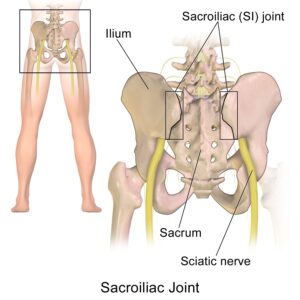 Back pain can originate from multiple locations. One of the more common causes of low back pain is dysfunction of the sacroiliac (SI) joints.
Back pain can originate from multiple locations. One of the more common causes of low back pain is dysfunction of the sacroiliac (SI) joints.
What are the SI joints?
Sacroiliac joints are the joints between the base of the spine (sacrum) and the pelvic bones (ilium). These joints act as shock absorbers between the back and legs.
What causes SI joint pain?
SI joint pain can be caused be a number of things including acute injury (i.e. fall, motor vehicle accident, etc), wear-and-tear (osteoarthritis), inflammatory conditions (i.e ankylosing spondylitis), pregnancy, and, less commonly, infections.
How is SI joint pain diagnosed and treated?
To help diagnose and treat this pain, an injection into the SI joint(s) is performed. Under x-ray guidance, a needle is introduced into the joint. Contrast dye is injected to ensure the needle is in the joint space. Once this is confirmed, either local anesthetic (for diagnostic purposes only) or a mixture of local anesthetic and steroid (for diagnostic and therapeutic purposes), is injected.
 How long will a steroid injection provide pain relief?
How long will a steroid injection provide pain relief?
If a therapeutic injection is performed, this can provide an average of 6-12 months of relief. However, each patient responds differently to these injections. We expect a minimum of three months of relief. If the steroid only provides temporary relief, radiofrequency ablation, fusion, or spinal cord stimulation may be options to treat this pain.
What restrictions are given after an SI joint injection?
There are minimal restrictions following an SI joint injection. Because pain may not be felt in the joint(s) due to the local anesthetic (bupivacaine or lidocaine), we typically recommend that you do not participate in strenuous activity the day of the procedure. This is discouraged as you may over exert yourself, causing more pain once the local anesthetic has worn off.
Is there anything else that can help SI joint dysfunction/pain?
It is recommended that these injections be performed in conjunction with physical therapy, stretching, regular exercise, and a healthy lifestyle to provide longer lasting relief. This can enable you to get back to the activities and quality of life you desire.
What if there is only short term relief with SI joint injections?
If SI joint injections only provide short term relief, there are other interventional treatment options such as radiofrequency ablation, SI joint fusion or spinal cord stimulation that may provide longer lasting relief..
